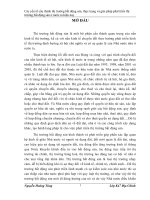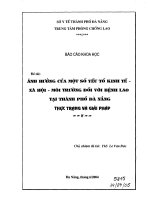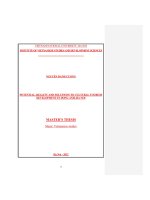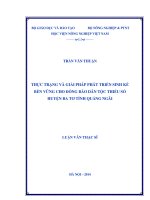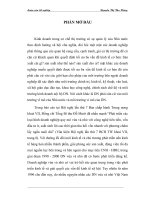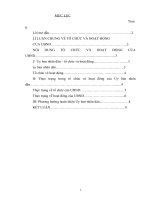Potential, reality and solutions to cultural tourism developing in Dong Anh, Hanoi Tiềm năng, thực trạng và giải pháp phát triển du lịch văn hóa huyện Đông Anh, Hà Nội
Bạn đang xem bản rút gọn của tài liệu. Xem và tải ngay bản đầy đủ của tài liệu tại đây (1.18 MB, 123 trang )
6
VIETNAM NATIONAL UNIVERSITY, HA NOI
INSTITUTE OF VIETNAMESE STUDIES AND DEVELOPMENT SCIENCES
NGUYEN DANH CUONG
POTENTIAL, REALITY AND SOLUTIONS TO CULTURAL TOURISM
DEVELOPMENT IN DONG ANH, HA NOI
MASTER’S THESIS
Major: Vietnamese studies
Ha Noi - 2012
7
VIETNAM NATIONAL UNIVERSITY, HA NOI
INSTITUTE OF VIETNAMESE STUDIES AND DEVELOPMENT SCIENCES
NGUYEN DANH CUONG
POTENTIAL, REALITY AND SOLUTIONS TO CULTURAL TOURISM
DEVELOPMENT IN DONG ANH, HA NOI
Master's thesis Major: Vietnamese studies
Code: 60 31 60
Supervisor: Prof.Dr. Truong Quang Hai
Hanoi - 2012
8
Contents
Page
Introduction
6
Chapter 1. Theoretical bases
15
1. Some basic issues of cultural tourism
15
1.1. Definition of Cultural tourism
15
1.1.1. Classification of cultural tourism
16
1.1.2. Differentiation between Cultural tourism and Tourism Culture
17
1.1.3. Some factors affecting cultural tourism
17
1.1.4. Cultural tourism resources (humanity tourism resource)
18
1.1.5. Cultural tourism programs
19
1.1.6. Cultural tourism’s products
19
1.2. Some other concepts relating to cultural tourism
20
1.2.1. Management and organization of tourism
20
1.2.2. Technology and material facilities of tourism
21
1.2.3. Tourist destination
23
1.2.4. Tourist
23
1.3. Preserving and promoting cultural heritage
24
1.4. Approaches
25
9
1.4.1. Systematic approaches
25
1.4.2. Approaches of area studies
25
1.4.3. Approaches of preserving and promoting cultural value
26
1.4.4. Approaches of sustainable tourism development
27
1.4.5. The general approaches
27
Chapter 2. The potential for cultural tourism in Dong Anh district
29
2.1. Geographical location
29
2.2. Natural conditions
30
2.3. Situation of socio – economic development
31
2.4. Humanity tourism resources
31
2.4.1. Historical and cultural relics
31
2.4.2. Revolutionary relic
40
2.4.3. Traditional festivals
42
2.4.4. Traditional handicrafts
49
2.4.5. Folk Art
50
2.5. Other cultural resources
51
2.5.1. Co Loa Studio
51
2.5.2. Village landscape
52
Chapter 3: The real state of dong anh’s cultural tourism
development
54
10
3.1. Organization and management of cultural tourism
54
3.1.1. The patterns of organization and management on cultural
tourism
54
3.1.2. Agencies and units do business in the cultural tourism
57
3.1.3. Local government
58
3.2. Material facilities and human resources for cultural tourism
59
3.2.1. Material and technical facilities for cultural tourism
59
3.2.2. The human resources for cultural tourism
64
3.3. The cultural tourism in some typical cultural tourist
attractions in Dong Anh
67
3.3.1. The cultural tourism in Co Loa
67
3.3.2. The historical and cultural relics of Sai temple
69
3.3.3. The cultural tourism in Van Ha villages
70
3.3.4. The traditional water puppetry of Dao Thuc
72
3.4. Some characteristics of cultural tourists in the typical cultural
tourist destinations
74
3.5. The typical cultural tourism programs
76
3.6. The conservation of humanity tourism resources
78
3.7. Assessing strengths and weaknesses, opportunities and
challenges
80
11
Chapter 4: The orientation and solutions to the cultural tourism
development in Dong Anh
84
4.1. The foundation for the orientation
84
4.1.1. The government’s policies and Hanoi’s plans for development
84
4.1.2. The practical basis
86
4.2. The orientation for the cultural tourism development in
Dong Anh
87
4.2.1. Strengthening the tourism organization and management
87
4.2.2.Speeding up the promotion for tourism
88
4.2.3. Speeding up the tourism linkages
88
4.2.4. Diversifying tourism products and improving the quality of
these products
89
4.2.5. Enhancing the technical infrastructure and human resources
of tourism
90
4.3. The solutions to the cultural tourism development in Dong Anh
91
4.3.1. The organization and management of tourism
91
4.3.2. Investment in infrastructure and technical facilities of tourism
95
4.3.3. Developing the products of local cultural tourism
97
4.3.4. The solutions to developing the human resources of tourism
99
4.3.5. Promoting and advertising tourism
100
12
4.3.6. The solutions to heritage conservation
102
Conclusion
106
List of references
108
13
LIST OF TABLES
Page
Figure 1. The gap in the organization and managementof the cultural
tourism in Dong Anh
56
Table 2. The status of accommodation establishments in Dong Anh (as
of 31/10/2011)
60
Table 3. Status transporter tourists in Dong Anh
63
Table 4. The present situation of travel business in Dong Anh
64
Table 5. The educational level of human resources in the cultural
tourism in Dong Anh
66
Table 6. The number of tourists to Co Loa cultural tourism attraction
(2008-2010)
69
Table 7. The number of international tourists to the water puppetry
ward of Dao Thuc
73
Table 9. The survey results of tourists’ characteristics in Dong Anh
75
INTRODUCTION
14
1. Theme’s imperative
Currently, cultural tourism plays an important role in tourism
developingment in many countriesnations, especially developing countries that
Vietnam belongs to. Cultural tourism activitiesis basesd on the traditional
cultural characteristics of thea community . Thus, they are and promotesd them -
as an internal source to helpeliminate hunger, and reduce poverty and create
alleviation as we as provide opportunities for the community to develop rapidly
and sustainability develop communityly.
Dong Anh is a locality with rich and distinctive traditional culture
connected to the historical struggles for the Vietnamese’s national construction
and defense. Co Loa temple is a famous historical heritagerelic with special
values in Vietnamese nation’s history and cultures. At present, the cultural
tourism destination not only attracts domestic tourists but also international ones.
Besides that, a system of cultural – historical relics there are many (temples,
pagodas, shrines) which are in cultural – historical heritage system located
around all the villages and have been ranked already is. They become a precious
resource in cultural tourism. Moreover, this is the area storing historical
heritagesrelics during the war for our independence, such as: Nam Hong tunnel
in the struggle against the colonial Francench colonists, ATK heritagesrelics
linked to the revolutionary fighting of ourVietnam’s Communist Party leaders….
They areIt is also an attractive humanistic resources useful for the
developingment of cultural tourism in Dong Anh. In addition, many interesting
festivals and traditional typeforms of arts with pround national characteridentity
such as Ca Tru, traditional theatre opera, Cheo, water puppet or freestyle
wrestling in the towns of Thuy Lam, Kim Chung, Nam Hong, Bac Hong, Kim
15
No, Hai Boi, Lien Ha, Duc Tu, Uy No, Tien Duong, Co Loa, Vinh Ngoc and
Viet Hung are also found in this area as: Ca Tru, traditional theatre opera, Cheo,
water puppet or freestyle wrestling in many different towns such as: Thuy Lam,
Kim Chung, Nam Hong, Bac Hong, Kim No, Hai Boi, Lien Ha, Duc Tu, Uy No,
Tien Duong, Co Loa, Vinh Ngoc, Viet Hung. Beside thatAdditionally, several
traditional occupations such as carving, lacquer, furniture in the village of Van
Ha, Lien Ha, Thuy Lam and Duc Tu and bamboo handicraft in Van Noi and Mai
Lam in different villages are stored, such as: carving, doing lacquer, furniture in
Van Ha, Lien Ha, Thuy Lam, Duc Tu and bamboo handicraft in Van Noi, Mai
Lam.
Dong Anh wais located at the important strategic geographic position for
Hanoi’sthe socio-economic developingment in Hanoi in particular and in theall
the whole country in general. It is the suburb district on the Northern gateway to
Hanoi capital with two important railways going through: Hanoi – Thai Nguyen
and Hanoi – Yen Bai. Besides, the important overlandroad system with 7.5 km
long plays a role in the lifeline as life-line traffic system in our country
connecting Noi Bai Iinternational aAirlineport to Hanoi center as Highway
23ATwo, Three, Road No.18, high-speed way Thang Long – Noi Bai highway.
This traffic advantage makes good premise to promote the social,o- economic
and cultural development of the district. At present, in Being in the process of
industrialization, big industrial zones have been built and rungone into
workingoperation, (the Nothern industrial zone of Thang Long …) which made
a breakthrough step in the socio-economic development in of Dong Anh.
Based on the Decision No.1081/QĐ-TTg on approving The mMaster plan
of the socio-economic developingment in Hanoi till 2020 and , in the direction of
16
towards 2030 with the viewpoint of building and developing Hanoi into the
motivation to the development promoteof the whole country, Dong Anh will be
directly connected to the center of Hanoi Capital. A system lot of big bridges
(Nhat Tan, Tu Lien and Dong Tru) going throughover the Red River haves been
planned and expected to be soon finished building (Nhat Tan Bridge, Tu Lien
Bridge, Dong Tru Bridge). This direct connection to Hanoi’s Center will bring
Dong Anh special advantages in socio-economic development. However, in the
situation that industrialization and urbanism is strongly taking place, several
existing problems need to be solved, such as: How to quickly and sustainably
develop in correlation betweenwith exploiting comparativeed advantages and
cultural character preservingation and promotioning the cultural values and
national identities? Is it possible for the diversified and unique cultural resources
in Dong Anh to strengthen its own cultural tourism development? If yes, how
will the real situation of cultural tourism activities take place? From that issue,
we have choosen the theme named “Potential, reality state and solutions for
developing the cultural tourism in Dong Anh, Hanoi” in order to answer those
e above questions. Concurrently, we recommend solutions for developingto the
cultural tourism development in this area and scientific arguments on , helping to
supply scientific arguments for policy planning tofor thedevelop socio-economic
development in general and cultural tourism in particular.
2. Researching situation
2.1. Domestic researching situation
Cultural tourism is one of many tourism kinds belonging to researching
subject in Tourism studies. Therefore, researching cultural tourism, we could not
ignore tourism the reseaching works on tourism in general and cultural tourism
17
in particular.
Tourism The reseaching works on tourism: The works on tourism studies
works are plentiful as Tourism studies reseaches several differentthe themes of
subjectstourism studies are at different viewpoints with indiversified and the
interdisciplinary method. Some of them could be listsed like: Tourism Overview
by Vu Duc Minh (1999), Tourism Overview, Education Publisher, Hanoi;
Tourism Economy and Tourism Studies by Dong Ngoc Minh and, Vuong Loi
Dinh (2000), Tourism Economy and Tourism Studies, Youth Publisher, Ho Chi
Minh City; Tourism Economy Handbook by Nguyen Van Dinh (2004), Tourism
Economy Handbook, Labor Publisher, Hanoi; Tourism Market by Nguyen Van
Luu (1998), Tourism Market, Vietnam National University Publisher; Tourism
Geography by Nguyen Minh Tue (1999), Tourism Geography, Ho Chi Minh
City Publisher; Resources and Tourism Environment by Pham Trung Luong
(2000), Resources and Tourism Environment, Education Publisher, Hanoi; and
Skills for tourism instruction by Bui Thanh Thuy (2005), Tourism Instruction
Skills, Hanoi Cultural University. ,… It’s these works that are useful documents
for references in for theis thesis executing process.
Cultural tourism The researching works Cultural tourism: Cultural
tourism is the separate researching subject subject of Tourism studies whose
works are comparatively plentiful as below: Tourism Culture by Le Thi Van
(2006), Tourism Culture, Hanoi Publisher, Hanoi; Vietnam famous communal
houses, pagodas and mausoleums by Tran Manh Thuong (1998), Vietnam
famous communal houses, pagodas and mausoleums, Information Culture
Publisher, Hanoi; and Cultural Tourism – Issues of argument, skill and
professional knowledge by Tran Thuy Anh, (Editor in Chief – 2010), Cultural
18
Tourism – Issues of argument, skill and professional knowledge, Vietnam
Education Publisher, Hanoi.… In general, there are many researching works ofn
Tourism Studies and Cultural Tourism in Vietnam;, however, not many of them
research profoundly abouton cultural tourism, especially, the cultural tourism in
different areas. wWhereas, Vietnam is a country of diversified cultures with
differentdistintive charactersfeatures.
It is necessary to list all works in the collection named “Thang Long – One
thousand years” in when researching of Dong Anh cultural tourism. Thisey are is
the researching works system ofon the several fields oflike socio-culture, art-
literature, history, geography, for policytics, – economy and Hanoi general
documents. These works are useful references for my thesis as which shows that
Dong Anh is inportant a part of Hanoi Capital. Some of these works are: Hanoi
Ca Tru in the past and at present byNguyen Duc Mau (2010), Hanoi Ca Tru in
the past and at present, Hanoi Publisher, Hanoi; Education and Confucianism
Examination in Thang Long – Hanoi by Bui Xuan Dinh (2010) Education and
Confucianism Examination in Thang Long – Hanoi, Hanoi Publisher, Hanoi;
Trading Villages, Trading Streets on developing way in Thang Long – Hanoi by
Vu Quoc Tuan (Chief Editor – 2010), Trading Villages, Trading Streets on
developing way in Thang Long – Hanoi , Hanoi Publisher, Hanoi,; Hanoi –
Landscapes and monuments by Luu Minh Tri (Editor in Chief – 2010), Hanoi –
Landscapes and monuments, Hanoi Publisher, Hanoi; Thang Long Philology by
Vu Khieu (Chief Editor - 2010), Thang Long Philology, Hanoi Publisher,
Hanoi; Hanoi – Landscapes and Monuments (Vol 2) by Luu Minh Tri (Editor in
Chief – 2010), Hanoi – Landscapes and Monuments (Vol 2), Hanoi Publisher,
Hanoi; the Sustainable Development in Hanoi by Nguyen Quang Ngoc (Chief
Formatted: Font: Not Italic
Formatted: Font: Italic
19
Editor – 2010), Sustainable Development in Hanoi Capital, Hanoi Publisher,
Hanoi; Thang Long – Hanoi Education, traditional and mordern method by
Nguyen Dinh Huong, Thang Long – Hanoi Education, traditional and mordern
method, Hanoi Publisher, Hanoi; Tran Lam Bien; Symbol world in Thang Long –
Hanoi Cultural monument by Assoc. Prof. Phd. Trinh Sinh (Co- Chief Editors –
2010), Symbol world in Thang Long – Hanoi Cultural monument, Hanoi
Publisher, Hanoi; Hanoi in Hung Vuong – An Duong Vuong times by Trinh Sinh
(Chief Editor – 2010), Hanoi in Hung Vuong – An Duong Vuong times, Hanoi
Publisher, Hanoi; and Thang Long – Hanoi’s Atlas by Truong Quang Hai (Chief
Editor), Thang Long – Hanoi’s Atlas, Hanoi Publisher, Hanoi….
It is said that “Thang Long – One thousand years” Collection, which
indirectly refers to culture in general and Dong Anh’s cultural tourism in
particularis, is a system of diversified works system relating to on severalvarious
fields. In addition, some research works researchingon the tourism development
in Hanoi such as Thang Long – Hanoi Tourism by Truong Sy Vinh (Editor in
Chief – 2010), Hanoi Publisher and Hanoi Encyclopedia (Vol 15 – Tourism) by
Hanoi People’s Committee (2010), Publisher of Dictionary and Vietnam
Encyclopedia, Hanoi partly referred to the cultural tourism in Dong Anh, such
as: Truong Sy Vinh (Editor in Chief – 2010), Thang Long – Hanoi Tourism,
Hanoi Publisher, Hanoi People’s Committee (2010), Hanoi Encyclopedia (Vol
15 – Tourism), Publisher of Dictionary and Vietnam Encyclopedia, Hanoi…
It is necessary to mention some Dong Anh’s specialized works inon
cultural and socio – economic fields like as:such as Co Loa Monograph by
Nguyen Quang Ngoc and , Vu Van Quan (Co- Editor if Chief – 2010), Co Loa
Monograph, Hanoi Publisher; and Dong Anh in Thang Long – Hanoi’s
20
thousands of years by, Dong Anh District Communist Pparty cCommittee –
People’s Council – Dong Anh People’s Committee (2010) Dong Anh in Thang
Long – Hanoi’s thousands of years, Hanoi Publisher, Hanoi… . These works
which showed presented the culture and history as well as natural and socio –
economic conditions of Dong Anh comprehensively and systematicaally is
highly general and interdisciplinary. Really, they are useful references materials
to complete the thesis.
In short, althoughIn spite of no speacialized works researching abouton
the tourism in Dong Anh, especially cultural tourism, the works ofn tourism
studies in general and cultural tourism in particular together with the works ofn
cultural and historical traditions, the works ofn the fightings for freedom and, the
ones ofn the natural and socio – economic conditions in Dong Anh are all useful
references materials in for me to performing the thesis.
2.2. Oversea researching situation
Some works onf Tourism studies in general and cultural tourism in
particular researcheddone by oversea scholars are quite plentiful. Some of typical
ones can be listed as belowfollows: Sustainable development by Bernd Von
Droste, Dana Silk and Mechtild Rossler, Sustainable development, P.6-8,
UNEIndustry dan Environment, 7,12/1992, Vol 15, N
o
3, Pari, 1992; Tourism
planning, An Integrated and Sustainable Development Approach by Edward
Inskepp, J.C, Tourism planning, An Integrated and Sustainable Development
Approach, Van Nostrand Reinhold, 1991; Tourims and Environment by Hens. I,
Tourims and Environment, M.S.C courso Free University of Brussel Belgium,
1999; and Tourism planning by Taylor Francis, Tourism planning, Newyork
Philadelphia, London, 1988 9377pp)….
21
In short, these above works are useful references materials in researching
the cultural tourism in Dong Anh.
3. The thesis’s aims and tasks
- To present some basic issues about the theoryies of cultural tourism
- To evaluate the potentials and, the reality state of the cultural
tourism in Dong Anh
- To recommend some suggestionsdirections and solutions ofto
exploiting and, developing cultural tourism together connecting with
strenthening and preserving the culture in Dong Anh
4. Subject and scope of researching
- Researching subject: Tangible and Intangible Cultural Heritages to
serve tourism activities
- Researching scope: the Ssystem of Tangible and Intangible Cultureal
heritages as well as some activities of the cultural tourism exploitingon in Dong
Anh
5. Researching methods
Some methods that the author uses to assess the potential and analyze real
state of cultural tourism developing in Dong Anh can be listed as below:
5.1. Method of aggregate analysing
This method has been used in most of the scientific researching works to
evaluate the potential of humanistic tourism resources as well as organize the
territory in the tourism exploitingon in Dong Anh. The cultural tourism is closely
connected with natural, socio – economic conditions. Hence, using this method,
the author can assess the potential and the real state of cultural tourism
developingment as well as recommend the most feasible solution to the tourism
Formatted: Indent: Left: 0", First line: 0.5",
Outline numbered + Level: 1 + Numbering
Style: Bullet + Aligned at: 0.25" + Tab after:
0.5" + Indent at: 0.5"
22
development in theis area.
5.2. Survey and interview methods
These methodsU are used in collecting more reliable information, this
method which helps the researcherus check information’s the accuracy of
information so that we can to recommend more credible conclusions. Basically,
the fielding aims at checking and adding documents about the resources and,
infrastructure which directly support cultural tourism activities and other related
materials. At the same time, we; comparinge and listing the geographic names in
details that are relatesd to tourism and initially evaluatinge some necessary
factors in setting up, and organizing the cultural tourism space in Dong Anh.
5.3. Method of outlining and mapping
This method plays an important role in researching any tourism space,
especially the scientific foundation for developing cultural tourism in general
and organizing its activities in particular. Mapping is mainly used in analyzing
the arrangement of cultural tourism resources (monuments of history, culture,
festivals, folk arts…) as well as infrastructure system and, technological material
facilities. This method will be more effective when being in connectedion with
GIS technology to analyze, evaluate the cultural tourism potential on the basingis
onf the importance and territory arrangement of resources and related conditions
as well as in order to find out the relationships in the cultural tourism space.
5.4. Material collecting
We use this method to collect figures, documents from such different
sources: as books, newspapers, reports in the Department of Culture, Sports and
Tourism, Management board of monuments, Tourist zones, Dong Anh Economic
Office, Hanoi Statistic yearbook, Websites from Central and Local agencies.
23
5.5. SWOT analysis method
The method is used to evaluate the Strengths, Weaknesses/Limitations,
Opportunities, and Threats in Dong Anh cultural tourism. It allows tohelps
research conditions systematically in the process of classifying, choosing and
recommending strategies as well as solutions to develop the cultural tourism in
Dong Anh and in the wholeall country.
5.6. Method of systematic analysis
Cultural tourism is a mobile, complicated system consisting of
severalvarious factors with different nature and these factors are often mutually
affectinged and , connectinged. Hence, we use this method to analyze the
diversifiedmultiple dimension linking and multiple way one inside – between the
out oside and the insidef of theat system so that we could evaluate and
recommend reliable conclusions, arguments for the potential as well as real state
of the locality’s cultural tourism developingment.
6. Some new scientific contributions of the thesis
The thesis’s researching outcome will contribute to evaluatinge the
potential and real state of Dong Anh’s cultural tourism in order to bring out some
suitable directions and solutions forto Dong Anh’s making process of cultural
tourism. In addition, it also provides scientific arguments for strategic planning
of the socio – economic development in the area.
7. Thesis’s structure
Chapter 1. Theoreetical tic baseis
Chapter 2. Chapter 2. The potentials of the cultural tourism in Dong Anh distrist
Dong Anh’s potentials of cultural tourism
Chapter 3. The real state of Dong Anh’s cultural tourism development
Formatted: Font: Not Bold
Formatted: Font: 14 pt, Not Bold
24
Chapter 4. 4The orientation and solutions to the cultural tourism
development in Dong Anh . Some directionsuggestions and solutions fotor Dong
Anh’s cultural tourism development
Chapter 1. THEORETICAL BASEIS
1. Some basic issues of cultural tourism
1.1. Definition of Cultural tourism
Nowadays, cultural tourism becomes the tendancy of tourism
developingment in many countries around the world, especially the countries
Formatted: Font: 14 pt, Not Bold
25
with diversified cultural traditions and national identitiescharacters. Cultural
tourism isIt mainly basesd on some cultural products to attract local tourists and
foreign ones all over the world.
According to UNWTO: “Cultural tourism consists of the activities of
persons to research, discover cultures such like as: performing arts, festivals,
different events, visiting monuments and temples, researching ofn nature, culture
or folk arts and pilgrimaging” (UNWTO)
1
.
As for ICOMOS: 3. Cultural tourism is the form of tourism whose
objective is the to discovery of monuments and sites. It exerts on these a
verybrings about positive effects insofar as iton the contributesion to their
maintenance and protection. This form of tourism justifiesproves in fact the
efforts that said in maintaining and preserving these relics and sites and
tenancesatisfying and protection the demand of the human community because
offor the sake of the socio-cultural and economic benefits (ICOMOS)
2
.
Theorectically, in many countries, especially in South east Asia (as for
SEAMEO SPAFA
3
), Cultural tourism is arrangedclassified into Ecologyy
tourism as ecology contains human ecology.
Vietnamese people like to live together with the nature so visiting
natural landscapes also visiting cultural monuments and heritage. “Cultural
tourism is a kind of planning, programming and designing trips to visit
ancient cultural works”.
According to Tourism Laws, 2005: “Cultural tourism means a type of
tourism that is based on the national cultural identity with the participation of
1
UNWTO: United Nation World Tourism Organization (Tổ chức Du lịch Thế giới).
2
ICOMOS: International Coucil On Monuments and Sites (Hội đồng Quốc tế các di chỉ và di tích)
3
SEAMEO SPAFA: Southeast Asian Ministers of Education Organization – Regional centre for Archaeology
anhd Fine Arts (Tổ chức các Bộ trưởng Giáo dục Đông Nam Á về Khảo cổ học và Mỹ thuật).
Formatted: Font: 14 pt
Formatted: Font: 14 pt
Formatted: Font: 14 pt
26
communities in order to preserve and bring into full play their traditional cultural
values”.
Prof. PhdDr. Tran Duc Thanh said: “Cultural tourism is a kind of tourism
that is based on cultural values of communities or an ethnic group, countries or
an area in order to educate and widen tourists’ knowledge and awareness”.
Prof. PhdDr. Nguyen Van Dinh said: “Cultural tourism is a type of
tourism that is based on the foundation of humanistic tourism resources and its
activities are mainly performed in human environment, especially in some
cultural architectural works made by communities, which have a deep attraction
to tourists”.
As a holeTherefore, cultural tourism aimings at changing cultural values
into tourism activities and cultural tourism acts to traditional culture is both as
the means medium and tourism trading the purpose to exploiting and trading
tourism.
1.1.1. Classification of cultural tourism
Based on many criteria, Cultural tourism could be divided into several
kinds. The following one is the most popular. division:
+ Tourism in learning cultural identity: The tourists aim at visiting
architectural works, arts, and learning about the people’s manners and customs.
This group contains researchers and students.
+ Tourism in cultural visiting: This type of tourism combines visiting
with researching and learning about cultures in a trip. It consists of tourists both
to visit, research and to sightsee, and satisfy their curiosity. Hence, they often
come to the destinations with cultural tourism and recreationamusement centers,
pastime activities. This group contains the tourists interested in adventure,
27
looking for new feelings and they are often young people.
+ Tourism combining cultural visiting with other purposes:
The tourists in this group consisting of people taking part in a conference,
seminars, anniversaries, and exhibition in combineation with going on a business
trip with visiting culture.
1.1.2. Differentiation between Cultural tourism and Tourism Culture
Having a look at this following table, we can realize this difference:
Cultural tourism
Tourism Culture
It is a type of tourism.
It is a behavioural system in
tourism activities and trade.
It is based on exploiting humanistic tourism
resources (resources of tangible and intangible
culture) for tourism activities.
It is based on the principles
of communicatingion and
behaviourings in tourism
activities.
1.1.3. Some factors affecting cultural tourism
Cultural tourism is a type of tourism that is affected by natural and socio –
economic factors. From the point of view stance of tourism, cultural tourism is
partly affected by climate factors, but it depends on demographic
characters,features such as gender, age, academic standard,education
background, career and, religion…. of tourists.
+ Sexual factor: affects tourism the motivation of going on holiday and
cultural tourism is men’s one of the main reasons major motivation that menfor
tourism because they are hardly tied with their family members and often have
with high academic standardeducation background and high social position…
28
status. like traveling because they are hardly tied by their families.
+ Age factor: Those who Mmainly joining the cultural tourism trips are
aged tourists and young ones. The aged ones have much free time and they are
interested in studying cultural traditions. Hence, they travel to study music, arts,
and national dishes. On the contrary, the young ones with a large quantity like
discovering, testing their selvesmselves, going far way from their home, being
free, and changing tourism destinations and often travel in small groups.
Therefore, they always ask for the newness with low price. TFor the middle-aged
tourists with high social standingstatus,, solvency and great self-control, they
often combine going on a business trips and travelling.
1.1.4. Cultural tourism resources (humanity tourism resources)
1.1.4.1. Cultural tourism resource (humanity tourism resource)
Tourism resources plays an important role – as adeveloping premise in
tourism development in general and cultural tourism in particular. In fact, the
more plentiful, attractivespecial and highly focused the tourism resources isare,
the higher themore attractive tourism activities areattract and the more effective
they become.
Beside that, Tourism resource is a historical category. The exploitation is
much up to socio-economic, scientific, technological and political conditions;
hence, it is being much widened. For that reason, Tourism resource contains the
exploited, being exploited and unexploited tourism resource.
Item 4 (Article 4 iIn Chapter I) of 2005 tourism law , article 4, No.4
saidstipulates: Tourism resources means natural landscapes, natural elements,
historical or cultural relics, and works of creative human labor or humanity
values that can be utilized to meet thetourist needs for tourism and constitute are
29
fundamental factors thatto form tourist resorts, tourist spots, tourist routes or
tourist cities.
In the researching scope of theis thesis, humanity tourism resources
include cultural traditions; cultural factors; folk literature; historical,
revolutionary, archaeological, and architectural relics; creative works by human
beings; and other tangible and intangible cultural heritages that can be used for
tourism purposes.
The humanity tourism resources created by humans haves been affected
by time, nature and humans theirmselves. Hence, itthese resources could easily
be destroyed, degraded and unrecoverable by itself even without man’shuman
impacts; Humanity tourism resources isare clearly regional. TheyIt has have
itstheir own specific values in each region and each, country. They are that was
influenced by the natural and socio – economic conditions in each region and in
each country. They areIt is useful in awareness, atypical entertainment or hasare
of a minor meaning; TheirIts advantage is mostly unseasonable (except for
festivals), independent of climate and other natural conditions; The hobbies of
Different the people coming to coming to the humanity tourism resources
haveare different and complicated hobbies….
1.1.4.2. Potentials of cultural tourism
The potentials of cultural tourism are the factors and conditions that are
existing or will exsist in the future, but they haven’t been used or are rarely used
in the activities of cultural tourism.
In this thesis, we define that the potentials of cultural tourism in Dong Anh
consist of such factors as the location, natural and socio-economic conditions
and cultural tourism rescources.
30
1.1.5. Cultural tourism programs
TheyIt aims at directing tourists to have their own feelings and realize the
cultural values on which tourism was built and that isare constructed on the
baseds onof their demands of for visiting and, learning about cultures as well as
the values of humanity cultural tourism resources.
1.1.6. Cultural tourism’s products
Cultural tourism’s products areis athe cultural products of culture that are
is brought toput in use in the tourism business activities and They areit is thea
components of the cultural tourism programs aiming at satisfying the tourists’
demands. Originally, theyit was are a cultural products, but cultural tourism’s
products mostly contains characteristics of the tourism ones. They become goods
for business to make economic benefits. In short, cultural tourism’s products
isare the tourism products exploited and used in the cultural tourism programs.
1.2. Some other concepts relating to cultural tourism
Cultural tourism is a type of tourism; hence, it could not be researched
without referring to some other concepts like as tourism organizingation and
managingement, tourism’s technology and material facilities, tourism spot,
tourists….
1.2.1. Management and organization of tourism
Management and organization of cultural tourism belongs to the
management and organization of tourism. Until now, there has not been a
unanimous definition about management. Especially, from 21
st
century, concepts
of management have become more plentiful. Several schools of scientific
management have shown different concepts as below:
-Taylor: “Being a manager, you should know: What you want others do
Formatted: Indent: Left: 0", First line: 0.5",
Bulleted + Level: 1 + Aligned at: 0.25" + Tab
after: 0.5" + Indent at: 0.5"


